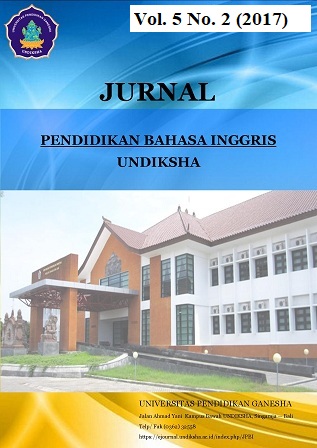AN ANALYSIS OF HESITATION PHENOMENA IN SECONDARY SCHOOL TEACHERS’ SPEECH AT AN INTERNATIONAL SCHOOL IN BADUNG.
DOI:
https://doi.org/10.23887/jpbi.v5i2.16537Abstract
Penelitian ini dilakukan untuk mempelajari hesitation phenomena (fenomena keragu-raguan) yang digunakan oleh guru sekolah menengah saat mengajar di sekolah internasional, Badung. Tujuan dari penelitian ini adalah (1) mengidentifikasi tipe-tipe hesitation yang digunakan guru saat mengajar; (2) mengetahui tipe mana yang paling sering muncul; dan (3) kenapa tipe tersebut yang paling sering muncul saat guru mengajar. Subjek dari penelitian ini adalah tiga guru yang merupakan penutur asli bahasa Inggris (English Native Speaker) dan menggunakan bahasa Inggris dalam mengajar. Obyek daari penelitian ini adalah hesitation yang digunakan oleh guru saat mengajar. Penelitian ini merupakan penelitian deskriptif kualitatif yang menggunakan metode observasi dan interview dalam mengumpulkan data. Data dianalisis menggunakan teori yang dikemukakan oleh Lacey and Luff (2009) yang terdiri dari 5 tahap yaitu Transcription, Organizing the Data, Familiarization, Coding, dan Themes. Berdasarkan teori hesitation yang dikemukakan oleh Rose (2013), terdapat enam tipe hesitation yang mucul yaitu: Silent Pause (11,4%), Filled Pause (52.1%), False Start (5.9%), Repair (4.2%), Repeat (12.7%), dan Lengthening (13.6%). Tipe hesitation yang paling sering muncul adalah Filled Pause. Para guru paling sering menggunakan Filled Pause karena Filled Pause dapat menghubungkan kalimat yang satu dengan yang lainnya saat mereka ragu, membuat guru terdengar lebih profesional dan para murid juga tidak akan sadar jika guru ragu-ragu berbicara.Kata Kunci : guru sekolah menengah, hesitation, ucapan
This research studied about hesitation phenomena occurred in secondary school teachers’ speech at an international school in Badung. The aims of this research were (1) to identify the types of hesitation occurred in the teachers’ speech; (2) to know which type of hesitation that mostly occurred; and (3) to know the reasons why such hesitation occurred. The subjects of the study were three teachers who taught in secondary school. They were English native speakers and used English in teaching the students. The object of the study was the hesitation used by the teacher while teaching the students. The research was a descriptive qualitative research and the data were collected by using observation method and interview method. The data were analyzed by using data analysis proposed by Lacey and Luff (2009) which consisted of five steps: Transcription, Organizing the Data, Familiarization, Coding, and Themes. According to the theory of hesitation proposed by Rose (2013), six types of hesitation were occurred in the teachers’ speech: Silent Pause (11,4%), Filled Pause (52.1%), False Start (5.9%), Repair (4.2%), Repeat (12.7%), and Lengthening (13.6%). The most dominant one was Filled Pause. Filled pause was used frequently because it could connect the teacher’s previous sentence with their following sentence, it was also more professional when using filled pause and the student would not notice or realize that the teacher hesitated.
keyword : hesitation, secondary school teacher, speech
Published
2019-01-07
Issue
Section
Articles
License
Authors who publish with the Jurnal Pendidikan Bahasa Inggris Undiksha agree to the following terms:- Authors retain copyright and grant the journal the right of first publication with the work simultaneously licensed under a Creative Commons Attribution License (CC BY-SA 4.0) that allows others to share the work with an acknowledgment of the work's authorship and initial publication in this journal
- Authors are able to enter into separate, additional contractual arrangements for the non-exclusive distribution of the journal's published version of the work (e.g., post it to an institutional repository or publish it in a book), with an acknowledgment of its initial publication in this journal.
- Authors are permitted and encouraged to post their work online (e.g., in institutional repositories or on their website) prior to and during the submission process, as it can lead to productive exchanges, as well as earlier and greater citation of published work. (See The Effect of Open Access)













